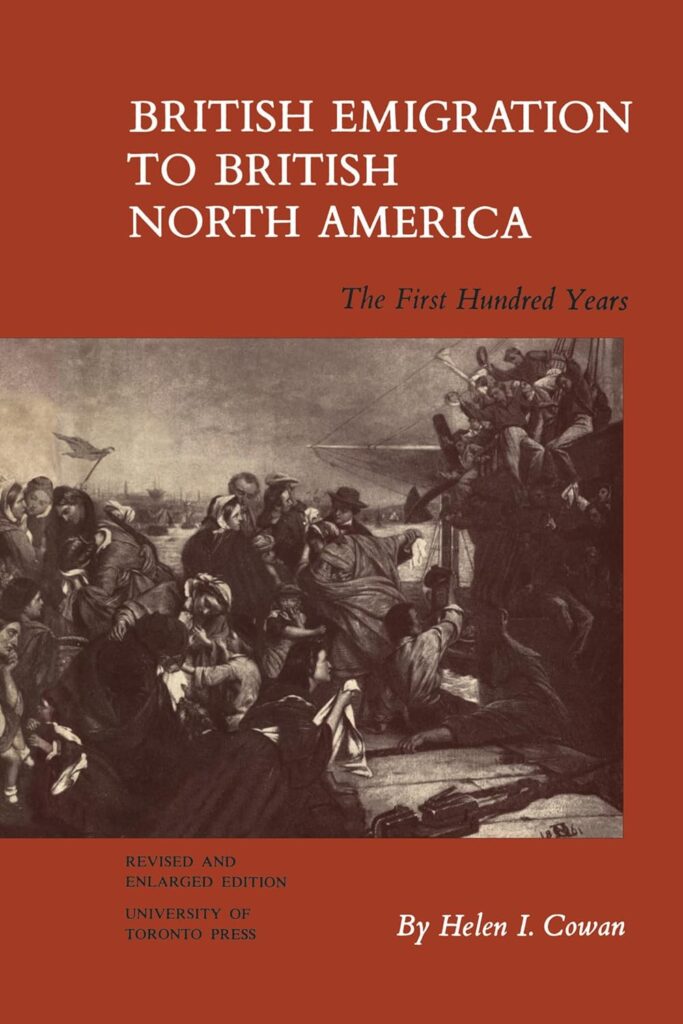
Helen I. Cowan, British Emigration to British North America: the first hundred years, Toronto, U of Toronto Press, 1961, Pp. xi, 321, illustrations, endnotes, bibliography
Helen Cowan’s study of British emigration remains the gold standard work on the subject. She had begun the work thirty years earlier but updated the research for this outstanding book.
This pioneering book captures the full variety of emigration policies and experiences from 1765 to 1860. In the earliest days, after 1765, British policy focused on establishing towns and looking after defence related issues. The early years were concerned with the series of wars with France that characterized British foreign policy from 1688 to 1815. During the American Revolution, the issue of resettling the Loyalists dominated British thinking. During these years, emigration was primarily military, but it included civilians mainly connected with trade and commerce. During these years the thinking was that emigration was good because people remained British even when in colonies.
The next period was characterized by concerns that widespread unemployment and rapid population growth were connected. There had been Highland clearances as earl as 1765, and many Scottish highlanders settled in the Appalachians and supported the British during the American Revolution. There were mixed feelings about emigration. The emigration of Macdonalds in 1786 had been preceded by public meetings to prevent their going, but there was also encouragement because of the Loyalist Scots being well treated. Mixed feelings dominated the period to 1820. The Selkirk settlers provided an example that lasted for decades of how landlords could support emigration to British lands and get support from the British government. Other emigrants, notably in the trades, paid their own travel expenses to emigrate to England or further afield.
The government briefly, between 1815 and 1818, toyed with the idea of assisting emigrants that were organized by towns. The Milburn Colony Settlers from Alston in Cumberland, England, were given some assistance when they emigrated in 1818, and settled in Smith township close to the future town of Peterborough. (p. 44) British policy generally supported military emigration, something that seemed important after the War of 1812 with the United States. There were major emigration projects, such as the Talbot settlements of western Upper Canada. There were also unofficial ways to receive benefits to support emigration (p. 47)
The Horton experiments of 1823 and 1825 marked a change in British government policy. Cowan discusses the Robinson settlers in a chapter on “The Rising Tide: to the Irish settlements.” She observes “In the last quarter century [since 1798] apparent overpopulation, unemployment, poverty and famine, risings of the people against landlords and agents, and all manner of activities of secret groups had reduced parts of the country to a more or less continuous state of insurrection.” (p. 65)
Lord Goulburn and Robert Wilmot Horton, both in the Colonial Office by 1823, had experience Goulburn in the Irish difficulties and Horton in the extensive pamphlet literature and the 1823 parliamentary commission on the labouring classes. Their efforts to subsidize emigration through the Colonial Office began with up to 500 Irish in the south of Ireland who were “disposed to emigrate.” Peter Robinson was selected at the end of May 1823, and he was advised to select emigrants from “the barony of Fermoy” which had the worst record for trouble makers and when selecting from the poorest unemployed might help the situation in Ireland, too. Cowan’s summary of the two Robinson emigrations is very balanced and dependable. There were many political hurdles, mainly in London, but the 1825 experiment proceeded as well as could be expected.
Robinson’s 1825 emigration coincided with meetings of the parliamentary committee on emigration and as Cowan observes the financial record was important, and these were not available for many years. Parliament had approved L40,480 for the 1825 expedition. Cowan concludes that the Irish did well because they were placed on superior agricultural land. (p. 80)
Cowan concludes that after the British government never again support emigration as it had in 1823 and 1825, the colonies had responsibility for “care of the incoming population.” (p. 84)
Cowan’s discussion continues to 1860. As well there are several documents presented in the appendices. Table 1 includes emigration figures 1815-1865. In 1823 and 1825, the total emigration to North American colonies was 11, 355 in 1823 and 8,741 in 1825. The figures are from Parliamentary papers, 1847-1867. Table V shows the distribution of emigrants by regions across Upper and Lower Canada. Her bibliographical note is very useful.
Book Information:
Helen I. Cowan, a graduate of the University of Toronto and a former teacher of history, has published many articles and reviews on population movements in leading historical journals.
Copyright Date: 1961
Published by: University of Toronto Press
Pages: 340
ISBN-10 : 1442639423
ISBN-13 : 978-1442639423
For purchase on Amazon (Canada):

| About the Blogger |
|---|
| Elwood Jones is a prominent Peterborough historian, esteemed member of Nine Ships 1825 Inc., Professor Emeritus of History at Trent University, and archivist at Trent Valley Archives. With a prolific career, Elwood has authored a dozen historical books, several pamphlets, and numerous articles, including over 300 columns for the Peterborough Examiner. He also serves as the editor of the Heritage Gazette of the Trent Valley and has been a long-time editor for the Peterborough Historical Society and the Canadian Church Historical Society. |
0 Comments